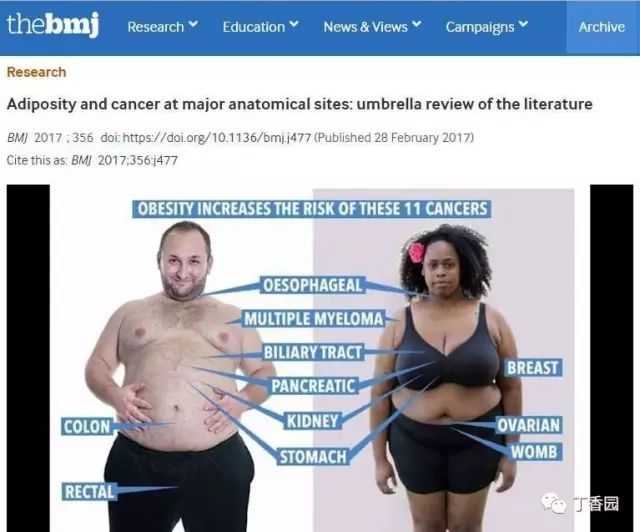
Obesity will lead to three highs (hypertension, hyperglycemia and hyperlipidemia) and increase the risk of cardiovascular and cerebrovascular diseases and endocrine diseases, as we all know.
However, the authoritative medical journal The BMJ (British Medical Journal) published a blockbuster article earlier this year, which proved that obesity is closely related to as many as 11 types of tumors, and obesity can significantly increase the incidence of these tumors.
In other words, to some extent, obesity is the primary carcinogenic factor!
The BMJ also included a video description
▼


Is how obese?

The article includes the results of different studies. These studies mainly use as many as seven criteria to measure obesity: Among them, BMI is the most commonly used indicator. BMI is equal to the square of height (m) divided by weight (kg). BMI ranges from 18 to 25 are normal, 25 to 30 are overweight, and above 30 are considered obese. (This standard is the American standard. For Chinese, the normal BMI range is 18.5 to 23.9, 24 to 27.9 are overweight, and above 28 are obese.) The risk of tumor development will increase with the increase of obesity. Such risks vary from organ to organ and from sex to sex.Body Mass Index (BMI) Waist circumference (hip circumference) Waist to hip ratio (weight) Weight gain (weight loss from bariatric surgery)

Which tumors prefer fat people?

The 11 tumors highly associated with obesity are: For men: Increased BMI poses the greatest threat to the biliary tract. For every 5% increase in BMI, men increase the risk of biliary tract tumors by 56%, while colorectal tumors seem to have a lower risk, but they also increase the risk of developing them by 9%. For women: For every 5% increase in BMI, the incidence of premenopausal breast cancer will increase by 11%, while the waist/hip ratio will increase by 0.1, and the risk of endometrial cancer will increase by 21%. Since these tumors participating in the study are the top ten common high-risk tumors for men and women, the potential incidence rate of tumors in obese people is very considerable in combination with their original incidence rate.Esophageal tumor, colon cancer, rectal cancer, cholangiocarcinoma, pancreatic cancer, endometrial cancer, multiple myeloma, breast cancer, gallbladder cancer, gastric cancer, ovarian cancer

Is all this proved by how?

In order to find enough evidence to prove the relationship between obesity and tumor in numerous medical papers, this paper adopts Umbrella Review, a new paper format.
To put it a better way, the Umbrella review is [a review of reviews].
As [a review in the review], the research object is not general scientific research articles, but a review and Meta articles on the correlation between obesity and tumor.
In order to find out which reviews are useful, the research has been conducted from 14,395 reviews (which is really voluminous! ) selected 110 of the most significant reviews.
However, among these reviews, they do not conform to the accurate literature retrieval standard, and 61 articles have been excluded, leaving only 49 core review articles.
At the same time, 204 Meta articles are mainly studied through these reviews, and these articles are also included in this study.
From these studies, the 49 core reviews 2,179 independent clinical trials, and in these trials, there are more than 6,600 clinical cases directly related to obesity, while there are more than 1.76 million control populations for analysis.
All these ensure the reliability of this [review in the review], and the conclusion drawn from these data is currently the highest level of evidence in the field of evidence-based medicine.

The weight has exceeded the standard, how to do?

See here, certainly some people will ask: What should I do? Is it not far from the tumor? Fortunately, compared with other carcinogenic factors, obesity is a reversible carcinogenic factor. After all, there is no fat that cannot be reduced. It depends on whether you persist and work hard enough. There is no shortcut to lose weight, [shut up and keep your legs open], healthy diet and active exercise are indispensable. If it is really pathological severe obesity, surgical treatment can also be considered. All this is not only responsible for one’s own health, but also a responsibility to one’s family. Are you willing to take it? Click to experience 1 yuan and ask the doctor? This article is authorized to be reproduced from the public number [Clove Garden] Responsible Editor: Cat Capricorn References: [1] Kyrgiou, Maria, et al. “Adipose and cancer at major anatomical sites: umbrella review of the literature.” Bmj 356 (2017): j477. [2] Chen, Wanqing, et al. “Cancer statistics in China, 2015.” CA: a cancer journal for clinicians 66.2 (2016): 115-132. [3] Aromataris, Edoardo, et al. “Summarizing systematic reviews: methodological development, conduct and reporting of an umbrella review approach.” International Journal of evidence-based healthcare 13.3 (2015): 132-140.

